A Machine Learning Based Discharge Prediction of Cardiovascular Diseases Patients in Intensive Care Units
Abstract
1. Introduction
2. Literature Review
3. Context and Methods
3.1. Mathematical Context
3.2. Data Description
3.3. Preprocessing
4. Results and Implementation
5. Discussion
| Ref | Methods and Approach | Dataset | Metrics and Results | Scoring of Recommendation Strength |
|---|---|---|---|---|
| [97] | Focus: prognostication of clinical outcomes in ICUs. Methods: multivariate imputation by chained equations for missing data imputation. Adaboost, parRF (parallel implementation of a random forest), SVMRadialWeights (SVM with radial basis function kernel and class weights), avNNet (averaged Neural Network) and deep NN as classifiers. | Critical Care Health Informatics Collaborative (CCHIC) data infrastructure (22,514 intensive care admissions of which 21,911 were used in the study; 90.8% of them were alive at discharge.) | On day 2 (AUC): parRF: 0.853 simple and 0.857 cumulative. avNNet: 0.864 simple and 0.879 cumulative. Adaboost: 0.862 simple and 0.879 cumulative. svmRadialWeights: 0.849 simple and 0.884 cumulative. DeepNN: 0.881 simple and 0.895 cumulative | Larger data improves model’s performance. |
| [98] | Focus: mortality prediction, LOS prediction and ICD-9 code group prediction. Methods: SAPS-II (Simplified Acute Physiology Score) and SOFA. Super learner models, RNN and FFN. | Medical Information Mart for Intensive Care III (MIMIC-III) (v1.4) | SuperLearner-I: AUROC = 0.8448 and AUPRC = 0.4351. SuperLearner-II: AUROC = 0.8701 and AUPRC = 0.4991. FFN: AUROC = 0.8496 and AUPRC = 0.4632. RNN: AUROC = 0.8544 and AUPRC = 0.4519. MMDL: AUROC = 0.8664 and AUPRC = 0.4776. Scoring methods: 0.8035 AND 0.7322 for AUROC (SAPS-II and SOFA respectively), AUPRC: 0.3586 for SAPS-II and 0.3191 for SOFA. | Larger data improves model’s performance. |
| [99] | Focus: prediction of final diagnosis and clinical outcomes. Methods: universal language model fine-tuning for text classification (ULMFiT) | Medical Information Mart for Intensive Care III (MIMIC-III) | Accuracy: 80.3% for diagnosis top10, 80.5% procedure top10, 70.7% diagnosis top50, 63.9% procedures top50. | Larger data improves model’s performance. |
| [100] | Focus: in-hospital mortality prediction. Methods: deep learning networks. | Medical Information Mart for Intensive Care III (MIMIC-III) (42,818 hospital admissions of 35,348 patients) | Mortality prediction: AUROC: 0.9178 with data of all sources (AS) and 0.9029 with chart data (CD). PRAUC: 0.6251 for AS, 0.5701 for CD. LOS prediction: AUROC: 0.8806 for AS and 0.8642 for CD. PRAUC of 0.6821 and 0.6575, respectively with AS and CD. | Larger data improves model’s performance. |
| [101] | Focus: ICUs discharge prediction. Methods: random forest (RF) and logistic classifier (LC). | Bristol Royal Infirmary general intensive care unit (GICU) (1870 intensive care patients) and 7592 from MIMIC-III. | On the MIMIC dataset: AUROC(RF):0.8859, AUROC(LC): 0.8726. Accuracy (RF): 0.8531 and accuracy (LC): 0.8494. sensitivity (RF): 0.9049 and sensitivity (LC) is 0.9001. | Larger data improves model’s performance. |
| [102] | Focus: prediction of discharge location in ICUs. Methods: National Early Warning Score (NEWS/NEWS 2) | Surgical, coronary, cardiac surgery recovery, medical and trauma surgical intensive care patients with single admission in ICUs in a US hospital. | The NEWS AUROC (95% CI): all patients 0.727 (0.709–0.745); Coronary Care Unit (CCU) 0.829 (0.821–0.837); Cardiac Surgery Recovery Unit (CSRU) 0.844 (0.838–0.850); Medical Intensive Care Unit (MICU) 0.778 (0.767–0.791); Surgical Intensive Care Unit (SICU) 0.775 (0.762–0.788); Trauma Surgical Intensive Care Unit (TSICU) 0.765 (0.751–0.773). | Larger data improves model’s performance. |
| [103] | Focus: risk scoring in ICUs. Methods: attentive deep Markov model (AttDMM). | MIMIC-III with 53,423 ICU stays. | AttDMM with AUROC of 0.876. | Not specified |
| [104] | Focus: ICU readmission prediction after 24 to 72 h of discharge. Methods: fuzzy modeling and tree search feature selection technique. | MIMIC II (data of 4 different ICUs 26,655 patients, of which 19,075 are adults; 38% of the adult patients stayed at the medical ICU (MICU), 27% at the surgical ICU (SICU), 20% at the cardiac surgery recovery unit (CSRU) and 15% at the critical care unit (CCU)) | AUROC of 0.76 and p-value of 0.006 with sequential forward selection. AUROC of 0.68 and p-value under 0.05 with sequential backward elimination. | Not specified |
| [105] | Focus: length of stay prediction in ICUs. Methods: neural network (random forest) | MIMIC-III (31,018 chosen data points) | Accuracy of 80%. | Larger dataset might improve the model’s performance. |
| Our model | Preprocessing: Regularized Linear Processing, Ordinal encoding of categorical variables, Tree based Algorithm. Prediction tools: Auto-tuned stochastic Gradient Descent Regression, Decision Tree, Extreme Gradient Boosted Trees Regression with Early Stopping, Gradient Boosted Greedy Trees Regression with Early Stopping, Light Gradient Boosted Trees Regression with Early Stopping, Advanced Generalized Linear Regression Model (GLRM), Efficient Neural Network (ENET), AVG Blender | MIMIC-III | {18% 1, 36% 2, 72% 3}: Accuracy = 98%, RESIDUAL MEAN = 0.000001, Prediction time: 123,450.9 mS. {18% 1, 36% 2, and 80% 3}: Accuracy: 97.8%, RESIDUAL MEAN = 0.000001, Prediction time: 123,551mS. {18% 1, 46% 2, 72% 3}: Accuracy: 93.7%, RESIDUAL MEAN = 0.000319, Prediction time: 215,693 mS. {25% 1, 36% 2, 72% 3}: Accuracy = 96.5%, RESIDUAL MEAN = 0.00147 and Prediction time: 15,039.3 mS. 1: Validation, 2: Cross validation, 3: Holdout | Larger dataset improve model’s performance |
6. Conclusions and Perspectives
Author Contributions
Funding
Institutional Review Board Statement
Informed Consent Statement
Data Availability Statement
Conflicts of Interest
References
- Virani, S.S.; Alonso, A.; Benjamin, E.J.; Bittencourt, M.S.; Callaway, C.W.; Carson, A.P.; Chamberlain, A.M.; Chang, A.R.; Cheng, S.; Delling, F.N.; et al. Heart Disease and Stroke Statistics—2020 Update: A Report from the American Heart Association. Circulation 2020, 141, e139–e596. [Google Scholar] [CrossRef] [PubMed]
- Organisation for Economic Co-Operation and Development (OECD). Health Care Resources. Available online: https://stats.oecd.org/# (accessed on 12 February 2022).
- Bouch, M.C.F.E.D.C.; Thompson, J. Severity scoring systems in the critically ill. Contin. Educ. Anaesth. Crit. Care Pain 2008, 8, 181–185. [Google Scholar] [CrossRef]
- Mitton, C.; Smith, N.; Peacock, S.; Evoy, B.; Abelson, J. Public participation in health care priority setting: A scoping review. Health Policy 2009, 91, 219–228. [Google Scholar] [CrossRef] [PubMed]
- Makridakis, S.; Kirkham, R.; Wakefield, A.; Papadaki, M.; Kirkham, J.; Long, L. Forecasting, uncertainty and risk; perspectives on clinical decision-making in preventive and curative medicine. Int. J. Forecast. 2019, 35, 659–666. [Google Scholar] [CrossRef]
- Han, P.K.J.; Klein, W.M.P.; Arora, N.K. Varieties of Uncertainty in Health Care: A Conceptual Taxonomy. Med. Decis. Mak. 2011, 31, 828–838. [Google Scholar] [CrossRef]
- Luo, L.; Luo, L.; Zhang, X.; He, X. Hospital daily outpatient visits forecasting using a combinatorial model based on ARIMA and SES models. BMC Health Serv. Res. 2017, 17, 469. [Google Scholar] [CrossRef]
- Dhawale, T.; Steuten, L.M.; Deeg, H.J. Uncertainty of Physicians and Patients in Medical Decision Making. Biol. Blood Marrow Transplant. 2017, 23, 865–869. [Google Scholar] [CrossRef]
- Guo, T.; Fan, Y.; Chen, M.; Wu, X.; Zhang, L.; He, T.; Wang, H.; Wan, J.; Wang, X.; Lu, Z. Cardiovascular Implications of Fatal Outcomes of Patients With Coronavirus Disease 2019 (COVID-19). JAMA Cardiol. 2020, 5, 811–818. [Google Scholar] [CrossRef]
- Mehra, M.R.; Desai, S.S.; Kuy, S.; Henry, T.D.; Patel, A.N. Cardiovascular Disease, Drug Therapy, and Mortality in COVID-19. N. Engl. J. Med. 2020, 382, e102. [Google Scholar] [CrossRef]
- Wong, L.E.; Hawkins, J.E.; Langness, S.; Murrell, K.L.; Iris, P.; Sammann, A. Where Are All the Patients? Addressing COVID-19 Fear to Encourage Sick Patients to Seek Emergency Care. NEJM-Catal. 2020, 119, 187–189. [Google Scholar] [CrossRef]
- Jamshidi, S.; Parker, J.S.; Hashemi, S. The effects of environmental factors on the patient outcomes in hospital environments: A review of literature. Front. Arch. Res. 2019, 9, 249–263. [Google Scholar] [CrossRef]
- Mommersteeg, P.M.; Denollet, J.; Spertus, J.A.; Pedersen, S.S. Health status as a risk factor in cardiovascular disease: A systematic review of current evidence. Am. Heart J. 2009, 157, 208–218. [Google Scholar] [CrossRef] [PubMed]
- Rumsfeld, J.S.; Alexander, K.P.; Goff Jr, D.C.; Graham, M.M.; Ho, P.M.; Masoudi, F.A.; Moser, D.K.; Roger, V.L.; Slaughter, M.S.; Smolderen, K.G.; et al. Cardiovascular health: The importance of measuring patient-reported health status: A scientific statement from the American Heart Association. Circulation 2013, 127, 2233–2249. [Google Scholar] [CrossRef]
- Spertus, J.A.; Nerella, R.; Kettlekamp, R.; House, J.; Marso, S.; Borkon, A.M.; Rumsfeld, J.S. Risk of Restenosis and Health Status Outcomes for Patients Undergoing Percutaneous Coronary Intervention Versus Coronary Artery Bypass Graft Surgery. Circulation 2005, 111, 768–773. [Google Scholar] [CrossRef] [PubMed]
- De Jonge, P.; Ormel, J.; Brink, R.H.V.D.; Van Melle, J.P.; Spijkerman, T.A.; Kuijper, A.; Van Veldhuisen, D.J.; Berg, M.V.D.; Honig, A.; Crijns, H.J.; et al. Symptom Dimensions of Depression Following Myocardial Infarction and Their Relationship with Somatic Health Status and Cardiovascular Prognosis. Am. J. Psychiatry 2006, 163, 138–144. [Google Scholar] [CrossRef] [PubMed]
- Mallik, S.; Krumholz, H.M.; Lin, Z.Q.; Kasl, S.V.; Mattera, J.A.; Roumains, S.A.; Vaccarino, V. Patients With Depressive Symptoms Have Lower Health Status Benefits After Coronary Artery Bypass Surgery. Circulation 2005, 111, 271–277. [Google Scholar] [CrossRef] [PubMed]
- Morgan, A.L.; Masoudi, F.A.; Havranek, E.P.; Jones, P.G.; Peterson, P.N.; Krumholz, H.M.; Spertus, J.A.; Rumsfeld, J.S.; Cardiovascular Outcomes Research Consortium. Difficulty taking medications, depression, and health status in heart failure patients. J. Card. Fail. 2006, 12, 54–60. [Google Scholar] [CrossRef]
- Suwanno, J.; Petpichetchian, W.; Riegel, B.; Issaramalai, S.A. A model predicting health status of patients with heart failure. J. Cardiovasc. Nurs. 2009, 24, 118–126. [Google Scholar] [CrossRef]
- De Jong, M.M.J.; Moser, D.K.; Chung, M.L. Predictors of Health Status for Heart Failure Patients. Prog. Cardiovasc. Nurs. 2005, 20, 155–162. [Google Scholar] [CrossRef]
- Palazón-Bru, A.; Carbayo-Herencia, J.A.; Vigo, M.I.; Gil-Guillén, V.F. A method to construct a points system to predict cardiovascular disease considering repeated measures of risk factors. PeerJ 2016, 4, e1673. [Google Scholar] [CrossRef][Green Version]
- Brady, W.; De Souza, K. The HEART score: A guide to its application in the emergency department. Turk. J. Emerg. Med. 2018, 18, 47–51. [Google Scholar] [CrossRef] [PubMed]
- Than, M.P.; Flaws, D.F.; Cullen, L.; Deely, J.M. Cardiac Risk Stratification Scoring Systems for Suspected Acute Coronary Syndromes in the Emergency Department. Curr. Emerg. Hosp. Med. Rep. 2013, 1, 53–63. [Google Scholar] [CrossRef]
- Bourdeaux, C.; Ghosh, E.; Atallah, L.; Palanisamy, K.; Patel, P.; Thomas, M.; Gould, T.; Warburton, J.; Rivers, J.; Hadfield, J. Impact of a computerized decision support tool deployed in two intensive care units on acute kidney injury progression and guideline compliance: A prospective observational study. Crit. Care 2020, 24, 656. [Google Scholar] [CrossRef] [PubMed]
- Kong, G.; Lin, K.; Hu, Y. Using machine learning methods to predict in-hospital mortality of sepsis patients in the ICU. BMC Med. Inform. Decis. Mak. 2020, 20, 251. [Google Scholar] [CrossRef]
- Lin, K.; Hu, Y.; Kong, G. Predicting in-hospital mortality of patients with acute kidney injury in the ICU using random forest model. Int. J. Med. Inform. 2019, 125, 55–61. [Google Scholar] [CrossRef]
- Silva, I.; Moody, G.; Scott, D.J.; Celi, L.A.; Mark, R.G. Predicting In-Hospital Mortality of ICU Patients: The PhysioNet/Computing in Cardiology Challenge 2012. Comput. Cardiol. 2012, 39, 245–248. [Google Scholar]
- Becerra-Fernández, M.; Herrera, M.M.; Trejos, C.; Romero, O.R. Resources Allocation in Service Planning Using Discrete-Event Simulation. Ing. Univ. 2021, 25, 1–23. [Google Scholar] [CrossRef]
- Gruenberg, D.A.; Shelton, W.; Rose, S.L.; Rutter, A.E.; Socaris, S.; McGee, G. Factors influencing length of stay in the intensive care unit. Am. J. Crit. Care 2006, 15, 502–509. [Google Scholar] [CrossRef]
- Toptas, M.; Samanci, N.S.; Akkoc, I.; Yucetas, E.; Cebeci, E.; Sen, O.; Can, M.M.; Ozturk, S. Factors Affecting the Length of Stay in the Intensive Care Unit: Our Clinical Experience. BioMed. Res. Int. 2018, 2018, 9438046. [Google Scholar] [CrossRef]
- Kelly, M.; Sharp, L.; Dwane, F.; Kelleher, T.; Comber, H. Factors predicting hospital length-of-stay and readmission after colorectal resection: A population-based study of elective and emergency admissions. BMC Health Serv. Res. 2012, 12, 77. [Google Scholar] [CrossRef]
- Wang, Y.; Stavem, K.; Dahl, F.; Humerfelt, S.; Haugen, T. Factors associated with a prolonged length of stay after acute exacerbation of chronic obstructive pulmonary disease (AECOPD). Int. J. Chronic Obstr. Pulm. Dis. 2014, 9, 99–105. [Google Scholar] [CrossRef] [PubMed]
- Hachesu, P.R.; Ahmadi, M.; Alizadeh, S.; Sadoughi, F. Use of Data Mining Techniques to Determine and Predict Length of Stay of Cardiac Patients. Healthc. Inform. Res. 2013, 19, 121–129. [Google Scholar] [CrossRef] [PubMed]
- Sessler, D.I.; Sigl, J.C.; Kelley, S.D.; Chamoun, N.G.; Manberg, P.J.; Saager, L.; Kurz, A.; Greenwald, S. Hospital stay and mortality are increased in patients having a “triple low” of low blood pressure, low bi-spectral index, and low minimum alveolar concentration of volatile anesthesia. J. Am. Soc. Anesthesiol. 2012, 116, 1195–1203. [Google Scholar] [CrossRef] [PubMed]
- Jacobson, S.H.; Hall, S.N.; Swisher, J.R. Discrete-event simulation of health care systems. In Patient Flow: Reducing Delay in Healthcare Delivery; Springer: Boston, MA, USA, 2006; pp. 251–252. [Google Scholar]
- Hamrock, E.; Paige, K.; Parks, J.; Scheulen, J.; Levin, S. Discrete event simulation for healthcare or-ganizations: A tool for decision making. J. Healthc. Manag. 2013, 58, 110–124. [Google Scholar] [PubMed]
- Brailsford, S.C. System dynamics: What’s in it for healthcare simulation modelers. In Proceedings of the 2008 Winter Simulation Conference, Miami, FL, USA, 7–10 December 2008; pp. 1478–1483. [Google Scholar] [CrossRef]
- Faezipour, M.; Ferreira, S. A System Dynamics Perspective of Patient Satisfaction in Healthcare. Procedia Comput. Sci. 2013, 16, 148–156. [Google Scholar] [CrossRef]
- Zhou, J.; Wang, J.; Wang, J. A simulation engine for stochastic timed petri nets and application to emergency healthcare systems. IEEE/CAA J. Autom. Sin. 2019, 6, 969–980. [Google Scholar] [CrossRef]
- Young, T.; Eatock, J.; Jahangirian, M.; Naseer, A.; Lilford, R. Three critical challenges for modeling and simulation in healthcare. In Proceedings of the 2009 Winter Simulation Conference (WSC), Austin, TX, USA, 13–16 December 2009; pp. 1823–1830. [Google Scholar] [CrossRef]
- Wang, L. An agent-based simulation for workflow in Emergency Department. In Proceedings of the 2009 Systems and Information Engineering Design Symposium, Charlottesville, VA, USA, 24 April 2009; pp. 19–23. [Google Scholar] [CrossRef]
- Liu, Z. Modeling and simulation for healthcare operations management using high performance computing and agent-based model. J. Comput. Sci. Technol. 2017, 17, 87–88. [Google Scholar]
- Gaba, D.M. The Future Vision of Simulation in Healthcare. Simul. Health J. Soc. Simul. Health 2007, 2, 126–135. [Google Scholar] [CrossRef]
- Kumar, A.; Krishnamurthi, R.; Nayyar, A.; Sharma, K.; Grover, V.; Hossain, E. A Novel Smart Healthcare Design, Simulation, and Implementation Using Healthcare 4.0 Processes. IEEE Access 2020, 8, 118433–118471. [Google Scholar] [CrossRef]
- Mielczarek, B. Review of modelling approaches for healthcare simulation. Oper. Res. Decis. Vol. 2016, 26, 55–72. [Google Scholar]
- Mao-Guo, G.; Li-Cheng, J.; Dong-Dong, Y.; Wen-Ping, M. Evolutionary multi-objective optimization algorithms (EMO). J. Softw. 2009, 7, 75–81. [Google Scholar] [CrossRef]
- Conforti, D.; Guerriero, F.; Guido, R. Optimization models for radiotherapy patient scheduling. 4OR 2007, 6, 263–278. [Google Scholar] [CrossRef]
- Kim, Y.-J.; Yoo, J.-H. The utilization of debriefing for simulation in healthcare: A literature review. Nurse Educ. Pract. 2020, 43, 102698. [Google Scholar] [CrossRef] [PubMed]
- Fetter, R.B.; Thompson, J.D. Patients’ waiting time and doctors’ idle time in the outpatient setting. Health Serv. Res. 1966, 1, 66–90. [Google Scholar]
- Fetter, R.B.; Thompson, J.D. The Simulation of Hospital Systems. Oper. Res. 1965, 13, 689–711. [Google Scholar] [CrossRef]
- Jun, J.B.; Jacobson, S.H.; Swisher, J.R. Application of discrete-event simulation in health care clinics: A survey. J. Oper. Res. Soc. 1999, 50, 109–123. [Google Scholar] [CrossRef]
- Jin, X.; Sivakumar, A.I.; Lim, S.Y. A simulation based analysis on reducing patient waiting time for consultation in an outpatient eye clinic. In Proceedings of the 2013 Winter Simulations Conference (WSC), Washington, DC, USA, 8–11 December 2013; pp. 2192–2203. [Google Scholar] [CrossRef]
- Rising, E.J.; Baron, R.; Averill, B. A Systems Analysis of a University-Health-Service Outpatient Clinic. Oper. Res. 1973, 21, 1030–1047. [Google Scholar] [CrossRef]
- Evans, G.W.; Gor, T.B.; Unger, E. A simulation model for evaluating personnel schedules in a hospital emergency department. In Proceedings of the Winter Simulation Conference, Coronado, CA, USA, 8–11 December 1996; pp. 1205–1209. [Google Scholar] [CrossRef]
- Elbattah, M.; Molloy, O. Coupling Simulation with Machine Learning. In Proceedings of the 2016 ACM SIGSIM Conference on Principles of Advanced Discrete Simulation, New York, NY, USA, 15 May 2016; pp. 47–56. [Google Scholar] [CrossRef]
- Chen, N.; Xie, X.; Zeng, Z.; Zhong, X.; Brenny-Fitzpatrick, M.; Liegel, B.A.; Zheng, L.; Li, J. Improving Discharge Process at the University of Wisconsin Hospital: A System-Theoretic Method. IEEE Trans. Autom. Sci. Eng. 2019, 16, 1732–1749. [Google Scholar] [CrossRef]
- Chand, S.; Moskowitz, H.; Norris, J.B.; Shade, S.; Willis, D.R. Improving patient flow at an outpa-tient clinic: Study of sources of variability and improvement factors. Health Care Manag. Sci. 2009, 12, 325–340. [Google Scholar] [CrossRef]
- Li, Y. Study of cardiovascular disease prediction model based on random forest in eastern China. Sci. Rep. 2020, 10, 5245. [Google Scholar] [CrossRef]
- Badawi, O.; Breslow, M.J. Readmissions and Death after ICU Discharge: Development and Validation of Two Predictive Models. PLoS ONE 2012, 7, e48758. [Google Scholar] [CrossRef] [PubMed]
- Zimmerman, J.E.; Wagner, D.P.; Draper, E.A.; Knaus, W.A. Improving intensive care unit discharge decisions: Sup-plementing physician judgment with predictions of next day risk for life support. Crit. Care Med. 1994, 22, 1373–1384. [Google Scholar] [CrossRef] [PubMed]
- Cuadrado, D.; Riano, D.; Gomez, J.; BodI, M.; Sirgo, G.; Esteban, F.; Garcıa, R.; Rodrıguez, A. Pursuing optimal prediction of discharge time in icus with machine learning methods. In Proceedings of the Conference on Artificial Intelligence in Medicine in Europe, Poznan, Poland, 26–29 June 2019; Springer: Cham, Switzerland, 2019; pp. 150–154. [Google Scholar]
- Szubski, C.R.; Tellez, A.; Klika, A.K.; Xu, M.; Kattan, M.W.; Guzman, J.A.; Barsoum, W.K. Predicting Discharge to a Long-Term Acute Care Hospital After Admission to an Intensive Care Unit. Am. J. Crit. Care 2014, 23, e46–e53. [Google Scholar] [CrossRef] [PubMed]
- Muhlestein, W.E.; Akagi, D.S.; Kallos, J.A.; Morone, P.J.; Weaver, K.D.; Thompson, R.C.; Chambless, L.B. Using a guided machine learning ensemble model to predict discharge disposition following meningioma resection. J. Neurol. Surg. Part B: Skull Base 2018, 79, 123–130. [Google Scholar] [CrossRef] [PubMed]
- Brook, K.; Camargo, C.A.; Christopher, K.B.; Quraishi, S.A. Admission vitamin D status is associated with discharge destination in critically ill surgical patients. Ann. Intensiv. Care 2015, 5, 23. [Google Scholar] [CrossRef] [PubMed]
- Levin, S.; Barnes, S.; Toerper, M.; Debraine, A.; DeAngelo, A.; Hamrock, E.; Hinson, J.; Hoyer, E.; Dungarani, T.; Howell, E. Machine-learning-based hospital discharge predictions can support multidisciplinary rounds and decrease hospital length-of-stay. BMJ Innov. 2020, 7, 414–421. [Google Scholar] [CrossRef]
- Abad, Z.S.H.; Maslove, D.M.; Lee, J. Predicting Discharge Destination of Critically Ill Patients Using Machine Learning. IEEE J. Biomed. Health Inform. 2020, 25, 827–837. [Google Scholar] [CrossRef]
- Jaotombo, F.; Pauly, V.; Auquier, P.; Orleans, V.; Boucekine, M.; Fond, G.; Ghattas, B.; Boyer, L. Machine-learning prediction of unplanned 30-day rehospitalization using the French hospital medico-administrative database. Medicine 2020, 99, e22361. [Google Scholar] [CrossRef]
- Karboub, K.; Tabaa, M.; Dellagi, S.; Monteiro, F.; Dandache, A.; Moutaouakkil, F. Modeling and Validation of the Hospital’s Ambulatory and Inpatients Operations Using a Non-Homogenous Discrete Time Markovian Chains. IEEE Access 2021, 9, 103044–103055. [Google Scholar] [CrossRef]
- Ransom, H.; Olsson, J.M. Allocation of Health Care Resources: Principles for Decision-making. Pediatr. Rev. 2017, 38, 320–329. [Google Scholar] [CrossRef]
- Mitton, C.; Donaldson, C. Health care priority setting: Principles, practice and challenges. Cost Eff. Resour. Alloc. 2004, 2, 3. [Google Scholar] [CrossRef] [PubMed]
- American Hospital Association. Fast Facts on U.S. Hospitals, 2020. Chicago, IL: American Hospital Association. Available online: https://www.aha.org/statistics/fast-facts-us-hospitals (accessed on 18 March 2020).
- Cylus, J.; Permanand, G.; Smith, P.C.; World Health Organization. Making the Economic Case for Investing in Health Systems. What Is the Evidence That Health Systems Advance Economic and Fiscal Objectives? Available online: http://www.euro.who.int/__data/assets/pdf_file/0010/380728/pb-tallinn-01-eng.pdf (accessed on 11 February 2022).
- Johnson, A.; Pollard, T.; Mark, R. MIMIC-III Clinical Database (version 1.4). PhysioNet. 2016, 3. [Google Scholar] [CrossRef]
- Johnson, A.E.W.; Pollard, T.J.; Shen, L.; Lehman, L.-W.H.; Feng, M.; Ghassemi, M.; Moody, B.; Szolovits, P.; Celi, L.A.; Mark, R.G. MIMIC-III, a freely accessible critical care database. Sci. Data 2016, 3, 160035. [Google Scholar] [CrossRef] [PubMed]
- Goldfrad, C.; Rowan, K. Consequences of discharges from intensive care at night. Lancet 2010, 355, 1138–1142. [Google Scholar] [CrossRef]
- Goldberger, A.; Amaral, L.; Glass, L.; Hausdorff, J.; Ivanov, P.C.; Mark, R.; Stanley, H.E. PhysioBank, PhysioToolkit, and PhysioNet: Components of a new research resource for complex physiologic signals. Circulation 2000, 101, e215–e220. [Google Scholar] [CrossRef] [PubMed]
- Python Documentaries. Available online: https://pandas.pydata.org/ (accessed on 11 February 2022).
- Python Documentaries. Available online: https://numpy.org/ (accessed on 11 February 2022).
- Python Documentaries. Available online: https://scipy.org/ (accessed on 11 February 2022).
- Python Documentaries. Available online: https://www.tensorflow.org/learn (accessed on 11 February 2022).
- Python Documentaries. Available online: https://docs.python.org/3/library/time.html (accessed on 11 February 2022).
- Roth, G.A.; Johnson, C.; Abajobir, A.; Abd-Allah, F.; Abera, S.F.; Abyu, G.; Ahmed, M.; Aksut, B.; Alam, T.; Alam, K.; et al. Global, Regional, and National Burden of Cardiovascular Diseases for 10 Causes, 1990 to 2015. J. Am. Coll. Cardiol. 2017, 70, 1–25. [Google Scholar] [CrossRef] [PubMed]
- Manfredini, R.; De Giorgi, A.; Tiseo, R.; Boari, B.; Cappadona, R.; Salmi, R.; Gallerani, M.; Signani, F.; Manfredini, F.; Mikhailidis, D.P.; et al. Marital Status, Cardiovascular Diseases, and Cardiovascular Risk Factors: A Review of the Evidence. J. Women’s Health 2017, 26, 624–632. [Google Scholar] [CrossRef]
- Lavie, C.J.; Arena, R.; Alpert, M.A.; Milani, R.V.; Ventura, H.O. Management of cardiovascular diseases in patients with obesity. Nat. Rev. Cardiol. 2018, 15, 45–56. [Google Scholar] [CrossRef]
- Kerac, M.; Trehan, I.; Weisz, A.; Agapova, S.; Manary, M. Admission and Discharge Criteria for the Management of Severe Acute Malnutrition in Infants Aged under 6 Months. Available online: https://www.who.int/nutrition/publications/guidelines/updates_management_SAM_infantandchildren_review8.pdf?ua=1 (accessed on 11 February 2022).
- Nates, J.L.; Nunnally, M.; Kleinpell, R.; Blosser, S.; Goldner, J.; Birriel, B.; Fowler, C.S.; Byrum, D.; Miles, W.S.; Bailey, H.; et al. ICU Admission, Discharge, and Triage Guidelines. Crit. Care Med. 2016, 44, 1553–1602. [Google Scholar] [CrossRef]
- Yancy, C.W.; Jessup, M.; Bozkurt, B.; Butler, J.; Casey, D.E., Jr.; Colvin, M.M.; Drazner, M.H.; Filippatos, G.S.; Fonarow, G.C.; Givertz, M.M.; et al. 2017 ACC/AHA/HFSA Focused Update of the 2013 ACCF/AHA Guideline for the Management of Heart Failure: A Report of the American College of Cardiology/American Heart Association Task Force on Clinical Practice Guidelines and the Heart Failure Society of America. J. Am. Coll. Cardiol. 2017, 70, 776–803. [Google Scholar]
- Titler, M.G.; Pettit, D.M. Discharge readiness assessment. J. Cardiovasc. Nurs. 1995, 9, 64–74. [Google Scholar] [CrossRef] [PubMed]
- Al-Qahtani, S.; Al-Dorzi, H.M.; Tamim, H.M.; Hussain, S.; Fong, L.; Taher, S.; Al-Knawy, B.A.; Arabi, Y. Impact of an Intensivist-Led Multidisciplinary Extended Rapid Response Team on Hospital-Wide Cardiopulmonary Arrests and Mortality. Crit. Care Med. 2013, 41, 506–517. [Google Scholar] [CrossRef] [PubMed]
- Pearse, R.M.; Moreno, R.P.; Bauer, P.; Pelosi, P.; Metnitz, P.; Spies, C.; Vallet, B.; Vincent, J.L.; Hoeft, A.; Rhodes, A. European Surgical Outcomes Study (EuSOS) group for the Trials groups of the European Society of Intensive Care Medicine and the European Society of Anesthesiology. Mortality after surgery in Europe: A 7 day cohort study. Lancet 2012, 380, 1059–1065. [Google Scholar] [CrossRef]
- Bell, C.M.; Brener, S.S.; Gunraj, N.; Huo, C.; Bierman, A.S.; Scales, D.C.; Bajcar, J.; Zwarenstein, M.; Urbach, D.R. Association of ICU or hospital admission with unintentional discontinuation of medications for chronic diseases. J. Am. Med. Assoc. 2011, 306, 840–847. [Google Scholar] [CrossRef]
- Knight, G. Nurse-led discharge from high dependency unit. Nurs. Crit. Care 2003, 8, 56–61. [Google Scholar] [CrossRef]
- Bakker, J.; Damen, J.; Van Zanten, A.R.H.; Hubben, J.H. Admission and discharge criteria for intensive care departments. Ned. Tijdschr. Voor Geneeskd. 2003, 147, 110–115. [Google Scholar]
- Badawi, O.; Liu, X.; Hassan, E.; Amelung, P.J.; Swami, S. Evaluation of ICU Risk Models Adapted for Use as Continuous Markers of Severity of Illness Throughout the ICU Stay. Crit. Care Med. 2018, 46, 361–367. [Google Scholar] [CrossRef]
- Desautels, T.; Das, R.; Calvert, J.; Trivedi, M.; Summers, C.; Wales, D.J.; Ercole, A. Prediction of early unplanned intensive care unit readmission in a UK tertiary care hospital: A crosssectional machine learning approach. BMJ Open 2017, 7, e017199. [Google Scholar] [CrossRef]
- Hosein, F.; Bobrovitz, N.; Berthelot, S.; Zygun, D.; Ghali, W.A.; Stelfox, H.T. A systematic review of tools for predicting severe adverse events following patient discharge from intensive care units. Crit. Care 2013, 17, R102–R110. [Google Scholar] [CrossRef]
- Araujo, T.G.; Rieder, M.M.; Kutchak, F.M.; Franco Filho, J.W. Readmissões e óbitos após a alta da UTI: Um desafio da terapia intensiva. Rev. Bras. Ter. Intensiva 2013, 25, 32–38. [Google Scholar] [CrossRef]
- Pollard, T.J.; Johnson, A.E.W.; Raffa, J.D.; Celi, L.A.; Mark, R.G.; Badawi, O. The eICU Collaborative Research Database, a freely available multi-center database for critical care research. Sci. Data 2018, 5, 180178. [Google Scholar] [CrossRef] [PubMed]
- Harris, S.; Shi, S.; Brealey, D.; MacCallum, N.S.; Denaxas, S.; Perez-Suarez, D.; Singer, M. Critical Care Health Informatics Collaborative (CCHIC): Data, tools and methods for reproducible research: A multi-centre UK intensive care database. Int. J. Med. Inform. 2018, 112, 82–89. [Google Scholar] [CrossRef] [PubMed]
- Nuthakki, S.; Neela, S.; Gichoya, J.W.; Purkayastha, S. Natural language processing of MIMIC-III clinical notes for identifying diagnosis and procedures with neural networks. arXiv 2019, arXiv:1912.12397. [Google Scholar]
- Rogers, P.; Wang, D.; Lu, Z. Medical Information Mart for Intensive Care: A Foundation for the Fusion of Artificial Intelligence and Real-World Data. Front. Artif. Intell. 2021, 4, 76. [Google Scholar] [CrossRef] [PubMed]
- McWilliams, C.J.; Lawson, D.J.; Santos-Rodriguez, R.; Gilchrist, I.D.; Champneys, A.; Gould, T.H.; Thomas, M.J.; Bourdeaux, C.P. Towards a decision support tool for intensive care discharge: Machine learning algorithm development using electronic healthcare data from MIMIC-III and Bristol, UK. BMJ Open 2019, 9, e025925. [Google Scholar] [CrossRef]
- Zaidi, H.; Bader-El-Den, M.; McNicholas, J. Using the National Early Warning Score (NEWS/NEWS 2) in different Intensive Care Units (ICUs) to predict the discharge location of patients. BMC Public Health 2019, 19, 1231. [Google Scholar] [CrossRef]
- Fialho, A.; Cismondi, F.; Vieira, S.; Reti, S.; Sousa, J.M.C.; Finkelstein, S. Data mining using clinical physiology at discharge to predict ICU readmissions. Expert Syst. Appl. 2012, 39, 13158–13165. [Google Scholar] [CrossRef]
- Gentimis, T.; Alnaser, A.; Durante, A.; Cook, K.; Steele, R. Predicting hospital length of stay using neural networks on mimic iii data. In Proceedings of the 2017 IEEE 15th Intl Conf on Dependable, Autonomic and Secure Computing, 3rd Intl Conf on Big Data Intelligence and Computing and Cyber Science and Technology Congress (DASC/PiCom/DataCom/CyberSciTech), Orlando, FL, USA, 6–10 November 2017. [Google Scholar]
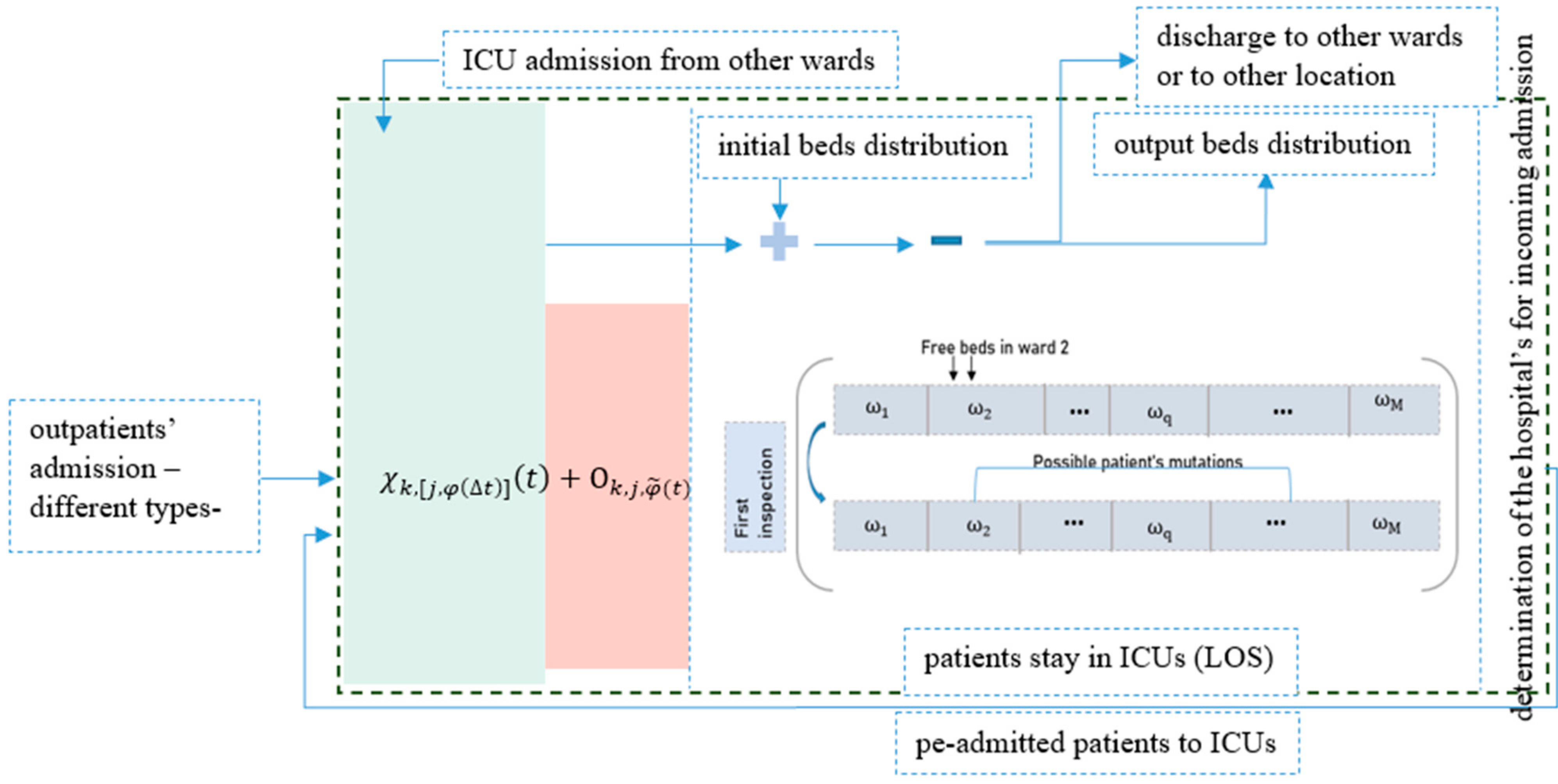
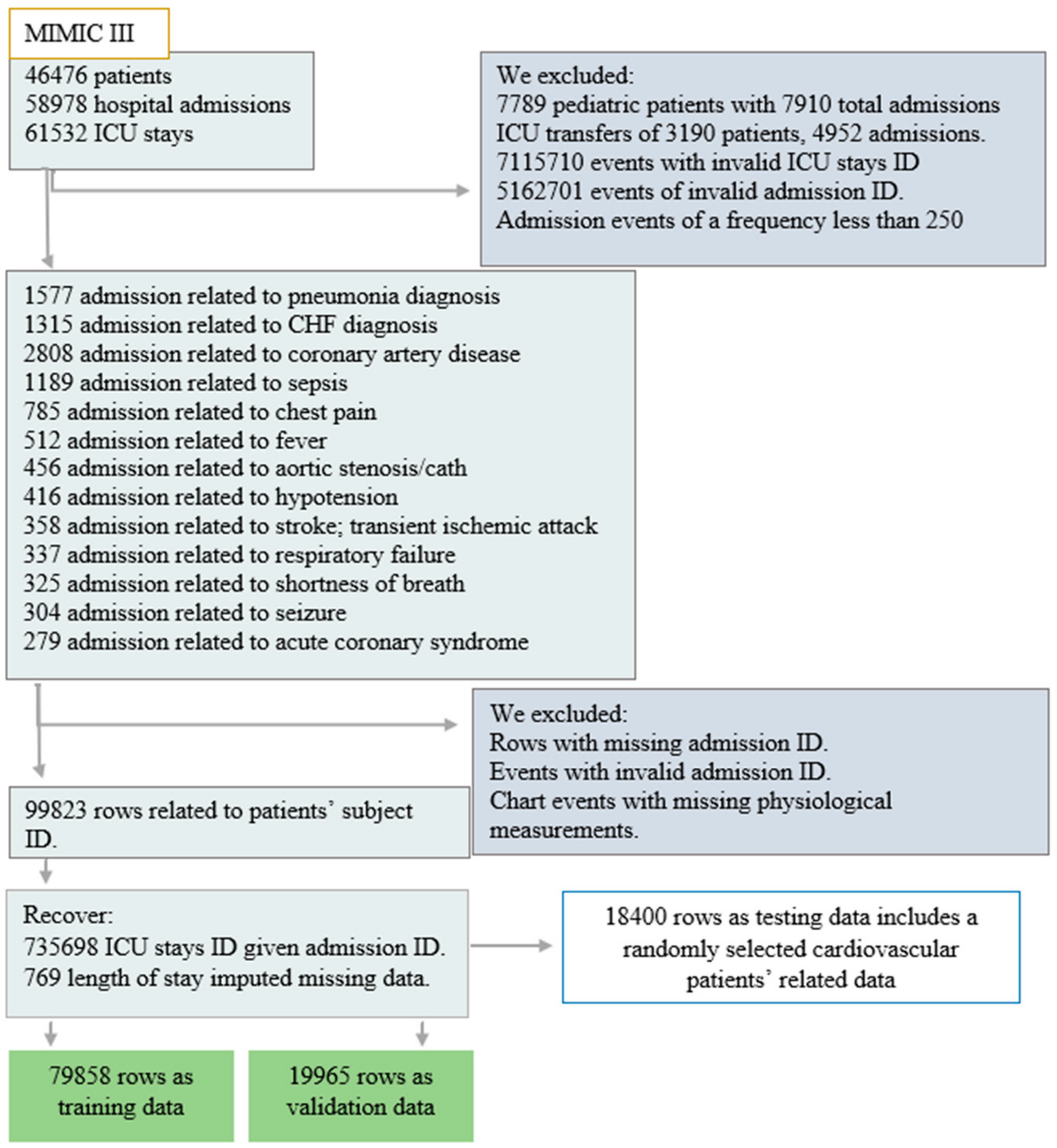
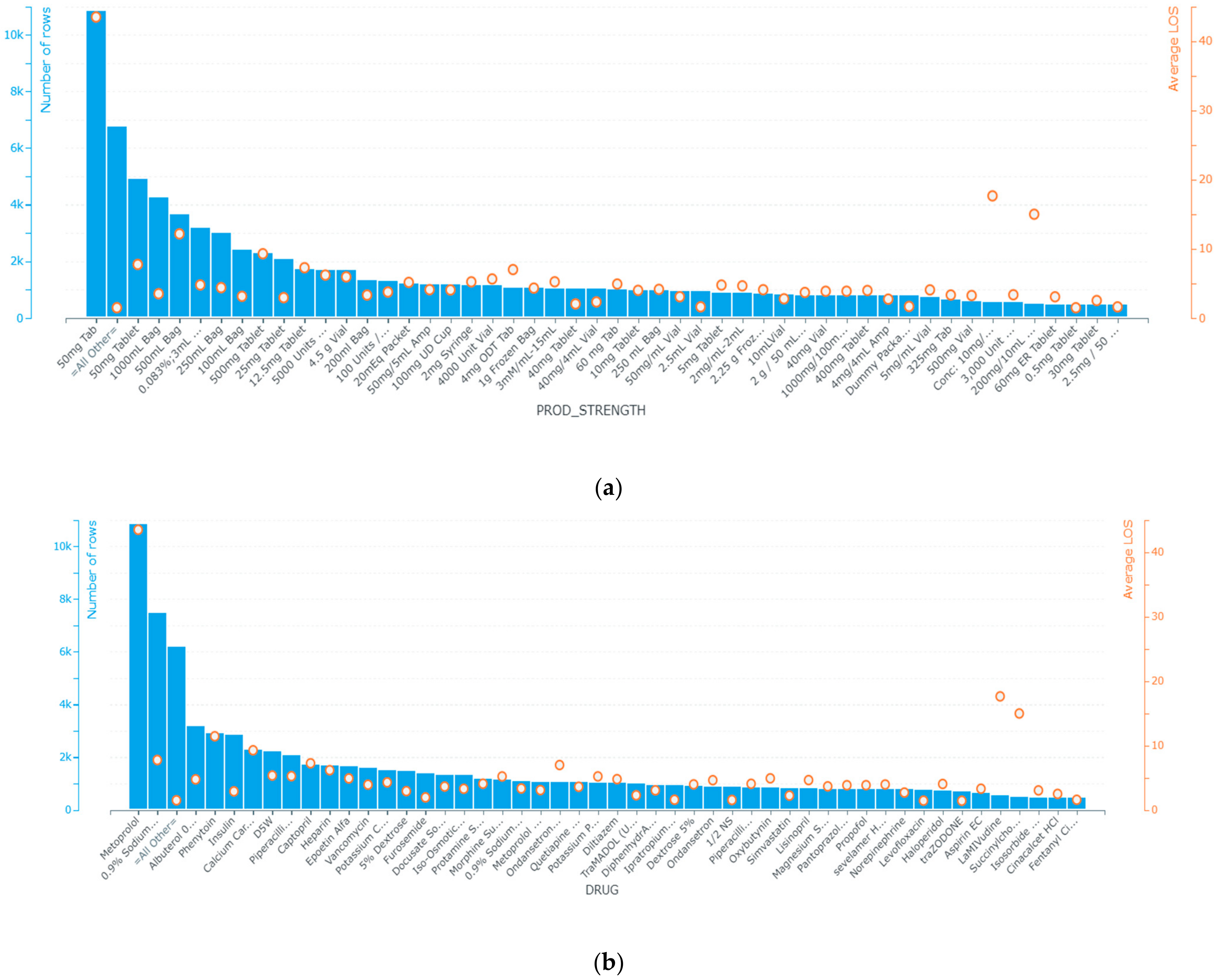

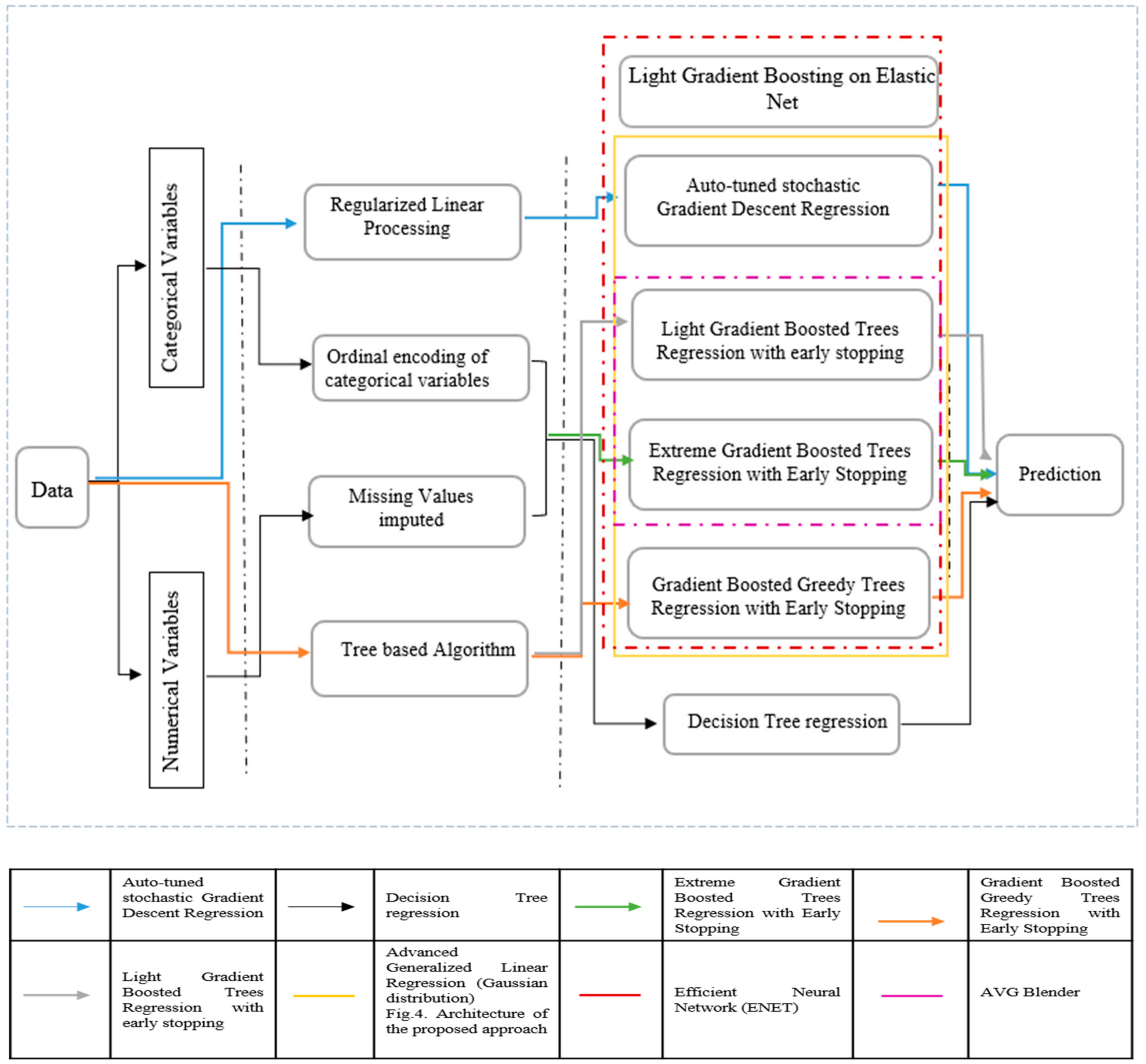
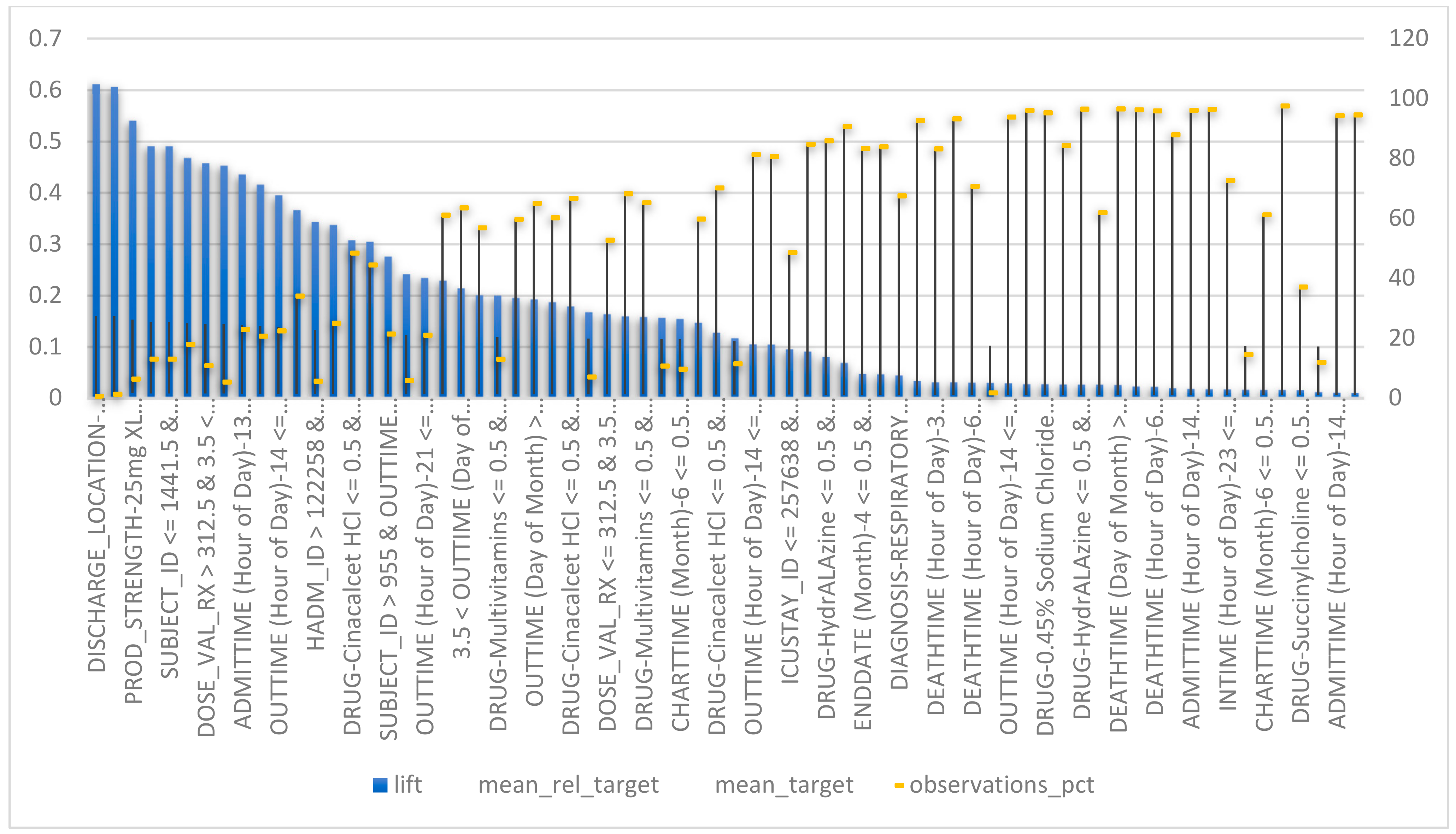
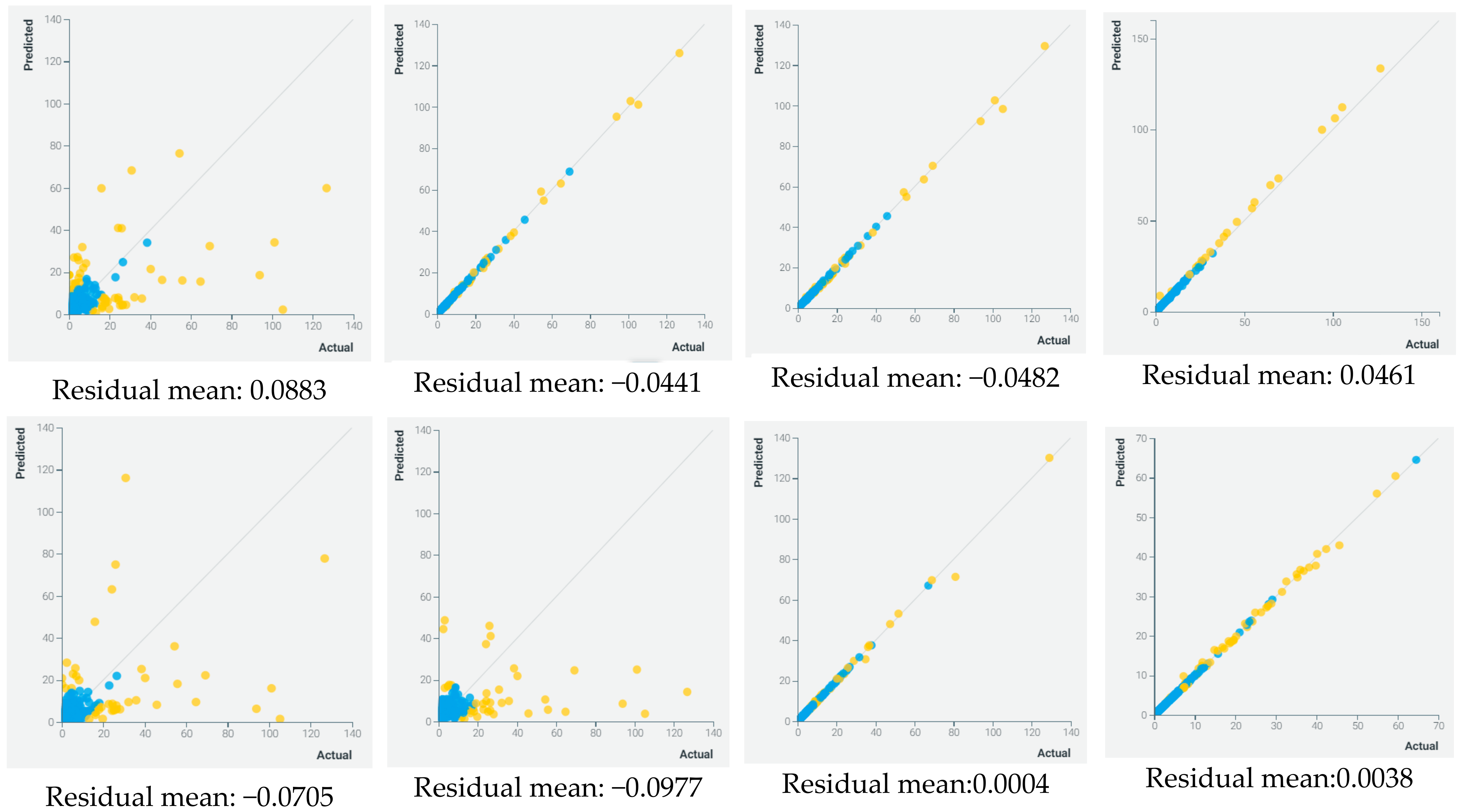
| Overall Population Characteristics | Dead at Discharge Characteristics | Alive at Discharge Characteristics | |
|---|---|---|---|
| Average age | 65 | 73 | 64 |
| Sex (% men) | 53% | 54% | 57% |
| Admission type: | |||
| Emergency | 2804 | 226 | 2577 |
| Elective | 1466 | 14 | 1451 |
| Urgent | 132 | 11 | 121 |
| Type of ICU: | |||
| Coronary artery disease | 2808 | 54 | 2753 |
| Congestive heart failure | 1315 | 175 | 1140 |
| Acute coronary syndrome | 279 | 22 | 257 |
| Average heart rate (bpm) | 80 | 100–110 | 60–100 |
| Average respiratory rate (cpm) | 21 | 12–20 | ≤12 or ≥20 |
| Prescription drugs: | |||
| Cholesterol lowering medications | 12.83% | 0.14% | 99.86% |
| ACE inhibitors | 14.62% | 0.38% | 99.62% |
| Bronchodilators | 10.66% | 0.47% | 99.53% |
| Diuretics | 9.1% | 1% | 99% |
| Insulins | 7.85% | 1.04% | 98.96% |
| Anticoagulants | 7.42% | 0.8% | 99.2% |
| Electrolytes | 13.22% | 0.66% | 99.34% |
| Beta blockers | 7.2% | 1.78% | 98.22% |
| Antiplatelet agents and DAPT | 3.46% | 3.58% | 96.42% |
| Anti-histamines | 3.44% | 0.53% | 99.47% |
| Quinolone antibiotics | 3.2% | 1.42% | 98.58% |
| Nitrates | 2.63% | 1.21% | 98.79% |
| Peptides | 1.36% | 1.01% | 98.99% |
| Glucose elevating agents | 1.63% | 5.88% | 94.12% |
| Antidysrhythmics | 0.89% | 4.6% | 95.4% |
| Calcium channel blockers | 0.35% | 3.95% | 96.05% |
| Sulfonic acid | 0.15% | 6.06% | 93.94% |
| Hospital length of stay | 2.9 days | 3.1 days | 2.7 days |
| Decision Trees | Gradient Boosted Models |
|---|---|
| Criterion: Entropy | Number of estimators: 2000 |
| Max depth: 10 | Learning rate: 0.3 |
| Splitter: Best | Criterion: MSE |
| Max features: log2 | Min sample leaf: 2 |
| Min samples leaf: 4 | Min samples split: 5 |
| Min samples split: 10 |
| Linear Regression | Trees Regression | Mixed (Blenders) | ||||||||
|---|---|---|---|---|---|---|---|---|---|---|
| Exp 1 | Model | LR * | TR1 * | TR2 * | TR3 * | TR4 * | B1 * | B2 * | B3 * | |
| Accuracy % | 0.89 | 0.783 | 0.917 | 0.761 | 0.726 | 0.98 | 0.935 | 0.961 | ||
| RM | Validation (18%) | 0.00682 | 0.18 | 0.00399 | 0.01714 | 0.01353 | - | - | - | |
| Cross Validation (36%) | 0.00575 | 0.09 | 0.00261 | 0.00953 | 0.01357 | - | - | - | ||
| Holdout (72%) | 0.00539 | - | 0.00173 | 0.00521 | 0.00312 | 0.0012 | 0.00158 | 0.00058 | ||
| Prediction time (mS) | 5627.83 | 3734.79 | 6914.43 | 22,443.8 | 17,452.56 | 123,450.9 | 123,800 | 69,376.8 | ||
| Exp 2 | Accuracy % | 0.88 | 0.77 | 0.91 | 0.77 | 0.756 | 0.978 | 0.91 | 0.956 | |
| RM | Validation (18%) | 0.00679 | 0.18 | 0.00399 | 0.01714 | 0.01353 | - | - | - | |
| Cross Validation (36%) | 0.00571 | 0.09 | 0.00261 | 0.00953 | 0.01357 | - | - | - | ||
| Holdout (80%) | 0.00512 | - | 0.00159 | 0.00503 | 0.00298 | 0.0012 | 0.00147 | 0.00054 | ||
| Prediction time (mS) | 5628.01 | 3699.45 | 6999 | 23,166.4 | 20,514.6 | 123,551 | 132,500 | 70,015.2 | ||
| Exp 3 | Accuracy % | 0.89 | 0.78 | 0.914 | 0.76 | 0.754 | 0.937 | 0.914 | 0.915 | |
| RM | Validation (18%) | 0.00659 | 0.18 | 0.00373 | 0.01694 | 0.0112 | - | - | - | |
| Cross Validation (46%) | 0.00551 | 0.085 | 0.00191 | 0.00958 | 0.01057 | - | - | - | ||
| Holdout (72%) | 0.00512 | - | 0.00159 | 0.00503 | 0.00298 | 0.80319 | 0.00147 | 0.00054 | ||
| Prediction (mS) | 5568 | 4697 | 7859 | 23,894.2 | 25,735.02 | 215,693 | 151,236 | 78,020 | ||
| Exp 4 | Accuracy % | 0.89 | 0.781 | 0.925 | 0.709 | 0.781 | 0.95 | 0.965 | 0.89 | |
| RM | Validation (25%) | 0.00614 | 0.1 | 0.00329 | 0.01658 | 0.01123 | - | - | - | |
| Cross Validation (36%) | 0.00541 | 0.09 | 0.00261 | 0.00953 | 0.01357 | - | - | - | ||
| Holdout (72%) | 0.00481 | - | 0.00148 | 0.00493 | 0.00298 | 0.000001 | 0.9947 | 0.00054 | ||
| Run time for 100 Predictions (mS) | 5750 | 3610.9 | 6990 | 32,548 | 24,590.4 | 133,511 | 15,039.3 | 699,081 | ||
Publisher’s Note: MDPI stays neutral with regard to jurisdictional claims in published maps and institutional affiliations. |
© 2022 by the authors. Licensee MDPI, Basel, Switzerland. This article is an open access article distributed under the terms and conditions of the Creative Commons Attribution (CC BY) license (https://creativecommons.org/licenses/by/4.0/).
Share and Cite
Karboub, K.; Tabaa, M. A Machine Learning Based Discharge Prediction of Cardiovascular Diseases Patients in Intensive Care Units. Healthcare 2022, 10, 966. https://doi.org/10.3390/healthcare10060966
Karboub K, Tabaa M. A Machine Learning Based Discharge Prediction of Cardiovascular Diseases Patients in Intensive Care Units. Healthcare. 2022; 10(6):966. https://doi.org/10.3390/healthcare10060966
Chicago/Turabian StyleKarboub, Kaouter, and Mohamed Tabaa. 2022. "A Machine Learning Based Discharge Prediction of Cardiovascular Diseases Patients in Intensive Care Units" Healthcare 10, no. 6: 966. https://doi.org/10.3390/healthcare10060966
APA StyleKarboub, K., & Tabaa, M. (2022). A Machine Learning Based Discharge Prediction of Cardiovascular Diseases Patients in Intensive Care Units. Healthcare, 10(6), 966. https://doi.org/10.3390/healthcare10060966






